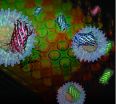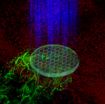(Press-News.org) Cold Spring Harbor, NY - The next time you are in a crowded room, or a meeting, or even at the park with your kids, take a look around. How many people are on their phone? Distractions invade every aspect of our lives. Status updates, text messages, email notifications all threaten to steal our attention away from the moment. While we fight the urge to check the phone, our brains are making constant judgment calls about where to focus attention. The brain must continually filter important information from irrelevant interference.
Scientists have hypothesized for decades about how the brain might accomplish this, but it has been challenging to find evidence to support the theories. Now, researchers at Cold Spring Harbor Laboratory (CSHL) have identified a neural circuit in the mouse brain that controls attention and sensory processing, providing insight into how the brain filters out distractions. The work has implications for devastating psychiatric disorders such as schizophrenia that are characterized at least in part by significant attention deficits.
The cortex is the region of the brain where most cognitive function happens. It is there that information is processed and interpreted, and decisions are made. But sensory information must pass through a neuronal gate, called the thalamus, on its way to the cortex. The thalamus, a ball-shaped bundle of neurons, is coated in a thin neuronal skin called the thalamic reticular nucleus, or TRN. As early as 1984, Nobel laureate Francis Crick hypothesized that the TRN might function like a guardian of the gate, regulating precisely which information is worthy of being passed on through the thalamus to the cortex for further analysis.
Researchers were intrigued by the hypothesis but faced technical struggles to prove that it was correct. Given the unique anatomical structure of the TRN - analogous to the skin on an apple - scientists were unable to target those neurons specifically. Still, evidence began to mount that the theory could be correct. Dysfunction of the TRN has been implicated in schizophrenia, and activity in the TRN correlates with sensory detection and attention.
Now, nearly 30 years after Crick's hypothesis, a team of CSHL scientists led by Associate Professor Bo Li has been able to provide the elusive evidence that the TRN regulates signaling between the cortex and thalamus. Together, the three structures form a circuit that controls attention and sensory processing in the mouse brain.
Using new viral technology combined with mouse models developed by CSHL Professor Josh Huang, Li and his team found a way to precisely target the TRN. They inactivated a single protein, called ErbB4, specifically in the TRN. Mutations in ErbB4 have been associated in prior studies with schizophrenia and other attention deficit disorders. The protein is found in large amounts in the TRN.
The team found that loss of ErbB4 in the TRN greatly affects the animal's ability to focus amid distractions. "When ErbB4 is absent, we saw that the connections between the cortex and the TRN become much stronger," explains Li. "This perturbs the role of the TRN as a guardian of the thalamus 'gate,' and provides a mechanism for the hypothesis that Crick proposed so long ago."
Beyond offering new insights into the neuronal basis of attention, the research suggests possible targets for therapeutics to treat attention deficit disorders as well as attention problems in broader illnesses including schizophrenia. According to Li, the next step is "to understand how loss of ErbB4 enhances the connections between the cortex and the TRN, which will hopefully enable us to pinpoint more drug targets in the future."
INFORMATION:
This work was supported by the Deutsche Forschungsgemeinschaft, the US National Institutes of Health, the Dana Foundation, NARSAD, the Louis Feil Trust, and the Stanley Family Foundation.
"ErbB4 regulation of a thalamic reticular nucleus circuit for sensory selection" appears online in Nature Neuroscience on December 15, 2014. The authors are: Sandra Ahrens, Santiago Jaramillo, Kai Yu, Sanchari Ghosh, Ga-Ram Hwang, Raehum Paik, Cary Lai, Miao He, Z. Josh Huang, and Bo Li. The paper can be obtained online at: http://dx.doi.org/10.1038/nn.3897
About Cold Spring Harbor Laboratory
Founded in 1890, Cold Spring Harbor Laboratory (CSHL) has shaped contemporary biomedical research and education with programs in cancer, neuroscience, plant biology and quantitative biology. CSHL is ranked number one in the world by Thomson Reuters for the impact of its research in molecular biology and genetics. The Laboratory has been home to eight Nobel Prize winners. Today, CSHL's multidisciplinary scientific community is more than 600 researchers and technicians strong and its Meetings & Courses program hosts more than 12,000 scientists from around the world each year to its Long Island campus and its China center. For more information, visit http://www.cshl.edu.
AMHERST, Mass. - Traditional genomic, proteomic and other screening methods currently used to characterize drug mechanisms are time-consuming and require special equipment, but now researchers led by chemist Vincent Rotello at the University of Massachusetts Amherst offer a multi-channel sensor method using gold nanoparticles that can accurately profile various anti-cancer drugs and their mechanisms in minutes.
As Rotello and his doctoral graduate student Le Ngoc, one of the lead authors, explain, to discover a new drug for any disease, researchers must screen billions ...
Researchers have released one of the most comprehensive assessments of the timing and amount of greenhouse gas emissions that each of the world's major economies could produce under different scenarios, i.e. without new climate policies, for the currently discussed pledges, and under a scenario that limits future temperature rise to 2°C. "The pledges made so far lead to earlier emission peaking in many countries, with 1-1.5 °C less total warming than without these policies, but not sufficient to meet the 2oC target. Under the proposed commitments, cumulative CO2 ...
Advocates of biotech crops and those who favor traditional farming practices such as crop diversity often seem worlds apart, but a new study shows that these two approaches can be compatible. An international team led by Chinese scientists and Bruce Tabashnik at the University of Arizona's College of Agriculture and Life Sciences discovered that the diverse patchwork of crops in northern China slowed adaptation to genetically engineered cotton by a wide-ranging insect pest. The results are published in the advance online edition of Nature Biotechnology.
Genetically engineered ...
Predictions of Greenland ice loss and its impact on rising sea levels may have been greatly underestimated, according to scientists at the University of Leeds.
The finding follows a new study, which is published today in Nature Climate Change, in which the future distribution of lakes that form on the ice sheet surface from melted snow and ice - called supraglacial lakes - have been simulated for the first time.
Previously, the impact of supraglacial lakes on Greenland ice loss had been assumed to be small, but the new research has shown that they will migrate farther ...
Sparks literally fly when a sperm and an egg hit it off. The fertilized mammalian egg releases from its surface billions of zinc atoms in "zinc sparks," one wave after another, a Northwestern University-led interdisciplinary research team has found.
Using cutting-edge technology they developed, the researchers are the first to capture images of these molecular fireworks and pinpoint the origin of the zinc sparks: tiny zinc-rich packages just below the egg's surface.
Zinc fluctuations play a central role in regulating the biochemical processes that ensure a healthy ...
When someone you know is wearing an unfamiliar hat, you might not recognize them. Georgia Institute of Technology researchers are using just such a disguise to sneak biomaterials containing peptide signaling molecules into living animals.
When the disguised peptides are needed to launch biological processes, the researchers shine ultraviolet light onto the molecules through the skin, causing the "hat" structures to come off. That allows cells and other molecules to recognize and interact with the peptides on the surface of the material.
This light-activated triggering ...
BOSTON - December 15, 2014 - In a study published today by Nature, researchers at Joslin Diabetes Center used a microscopic worm (C. elegans) to identify a new path that could lead to drugs to slow aging and the chronic diseases that often accompany it--and might even lead to better cosmetics.
The Joslin team looked at how treatments known to boost longevity in the one-millimeter long C. elegans (including calorie restriction and treatment with the drug rapamycin) affected the expression of genes that produce collagen and other proteins that make up the extra-cellular ...
New research into an Icelandic eruption has shed light on how the Earth's crust forms, according to a paper published today in Nature.
When the Bárðarbunga volcano, which is buried beneath Iceland's Vatnajökull ice cap, reawakened in August 2014, scientists had a rare opportunity to monitor how the magma flowed through cracks in the rock away from the volcano. The molten rock forms vertical sheet-like features known as dykes, which force the surrounding rock apart.
Study co-author Professor Andy Hooper from the Centre for Observation and Modelling ...
The carbon in the atmosphere, ocean, surface life, and other shallow, near surface reservoirs accounts for only about 10% of Earth's carbon. Where is the other 90%? What is it doing? Does it matter?
The Deep Carbon Observatory (DCO), an ambitious 10-year (2009-2019) program of exploration and experimentation, pursues the mysterious 90% while building a new scientific field with a network of scientists from more than 40 countries. Recent results from DCO researchers are filling in the global carbon puzzle with findings that extend our understanding of the origins and limits ...
Researchers at Yale and Boston University and their Russian collaborators have found that occasional heroin use by HIV-positive patients may be particularly harmful to the immune system and worsens HIV disease, compared to persistent or no heroin use.
The findings are published in the journal AIDS and Behavior.
"We expected that HIV-positive patients who abused heroin on an ongoing basis would have the greatest decreases in their CD4 count, but this preliminary study showed that those who abused heroin intermittently had lower CD4 cell counts, indicating a weakened ...






